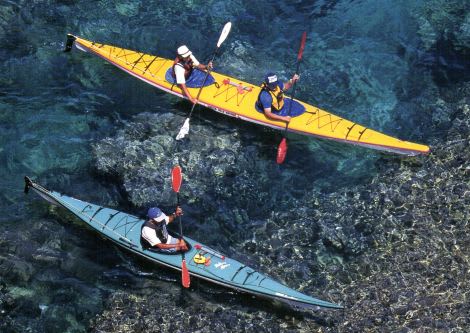
【スターウォーズデザイン エピソードⅠ】
すべてはデザインで決まる。

ドロイデカのコンセプト・デザイン
転がるドロイドの別のアイデアとしては、ロボットが一輪車に乗っているようなもであったと
いう(下図はダグ・チャンによるもの)。

ところで、月命日ということで宗安寺(親父)の帰りに金剛山寺(田中家)に墓参し、母を見
舞い、過日の記念日の抽選でランタンが当たったので単三乾電池4本を今週金曜に持って来る
ことを約束し帰り、ついでに白い金麦とサンルケーニャを買い帰宅。予定通り作業を終わらせ、
パソコンの不具合を修正する作業に移り、ホームページビルダーを再インストールとメールの
不具合修正。これで、日本文理大学(小幡章教授)との電子メール交換がスムーズにいくこと
を確認。安定感が戻って来るも、稼働率の関係で、オーバーヒートで、掌は低温火傷の状態は
変らず困っている。これはマイピーシーの能力の限界によるもので手の打ちようがないという
わけだ。

調子が戻ってきたので、趣味のカヤックと百名山踏破計画の残件処理に移る。カヤックの方は、
川旅を念頭に入れているので、フオールディング・カヤックとなる。これは、折り畳んでコン
パクトになり、電車など車以外の交通手段で持ち運びできるのが大きな魅力。自宅で保管する
際にも、折り畳める。フオールディング・カヤックは、艇を形どるフレームと、それを包む船
体布で構成され、フレームの素材はアルミが主流だが、ウッドやグラスファイバーなども使わ
れている。設計段階で充分な強度と耐久性を確保してあるので、選ぶ基準は各自の好み次第。
使い勝手の上の違いは、ウッド製のリブフレーム(艇のバウからスターンにかけて、横方向に
ろっ骨のように入っているフレーム)は強度を確保するために太くなり、その間に荷物を押し
込むのが困難になるといったところだろうか、これも工夫次第で気にならないレベルだ。とり
あえずは、二年かけて準備とこちらはスローペースでかまわない。


トレッキングは、上信越高原国立公園内にあり、深田久弥氏著作の『日本百名山』の一つに数
えられ、駒ケ岳、鋸山、鬼ケ面山などの登山口とし知られる雨飾山を来月10日前後と決め、市
民運動会前に済ませる予定。ここから、長野県北安曇郡小谷村は雨飾温泉まで4時間半だから、
立山連山とほとんど変わりない距離(349km)。糸魚川インターチェンジから車で60分、糸魚川
インターチェンジを降り、最初の信号を左折、R148を白馬方面へ約6km直進、フォッサマグナパ
ークを過ぎ「根知谷入口」を左折。約4km直進、シーサイドバレースキー場を過ぎ「山寺橋」
へ左折、橋を渡ったらすぐ右折、約6kmで雨飾温泉に到着。雨飾山の特徴は「猫の耳」と呼ば
れる二つの山頂で、双耳峰の南峰には三角点があり、北峰には石仏が並び、村内各所から、そ
の姿を見ることができるとか。見る角度によりその姿は様々に変化し、集落を守る神の山とし
て人々から慕われてきたという。この山の特徴は、新潟県糸魚川との県境に位置し、山頂から
の360°の展望は絶景とか、そのため 2,000mに届かない山ながら、多くの登山者が訪れとか。
天候に恵まれれば日本海を望めるのだ。
【いまごろ言い出せない鶚(ミサゴ)カルテル】
饗場野にオスプレイがやってくるというので、遅まきながら残件を処理しようしたが、いかんせ
ん、眼と脳の疲れはピークに。ここはひとまず後日処理することとしよう。ところで、この件で
も“すべてはデザインで決まる。”という言葉が覆い被さる世界となっている。
※「オスプレイ 事故調査めぐる重要証言」(2009年6月23日 米下院監視政府改革委員会での
アーサー・レックス・リボロ博士の証言)
※『MV-22 オスプレイ 明白で、不名誉で、致命的な嘘』
MV-22 Osprey Lies - Blatant,
Disgraceful, And Deadly
By Carlton Meyer
editor@G2mil.com
http://www.g2mil.com/V-22update.htm
7-8-1
Of all the U.S. military programs facing elimination, the V-22 Osprey program is most deserving. The M
V-22 is far too expensive and too unstable to conduct combat assaults. The February issue of G2mil con-
tains an article "The V-22 Fiasco" which should convince any sane person that this program is deeply
flawed. An April 20, 2001 report by POGO summarizes other MV-22 problems. Early this year, a "blue-
ribbon" panel consisting of a retired Marine General and two defense industry insiders was convened to
ensure continuation of this program. This bogus review panel traveled the nation to visit manufacturing
plants where the flawed MV-22s were built, but didn't find time to drive one hour outside Washington
DC to talk with the MV-22 test pilots based in Maryland.
The panel recommended that obvious technical problems should be fixed, and an expensive redesign is
now underway. The lightweight titanium hydraulic lines are too thin, so they will be replaced. Proper
testing should eliminate the software problems. The Bell-Boeing team became aware of these problems
during testing, but never fixed them, and 20 Marines died as a result. In private business, Bell-Boeing
would have paid millions of dollars to the families of the dead Marines. They would also be expected to
fix flaws in a product they
produced, but in the corrupt world of U.S. military contraiting, they will be paid even more money. The
Marines also want a .50 caliber gatling gun mounted, so this will further complicate matters.
Meanwhile, the production line will stay open to produce incomplete MV-22s, which will be parked until
the redesign work is finished. Then another billion dollars will be wasted to modify these 40 or more pre-
production lemons. This redesigned MV-22C should be ready to fly within a year, but will it be thoroughly
tested as promised? This would cost another billion dollars, take another two years, and may identify
more problems. As a result, Marine Generals may claim that the redesigned Osprey was already tested.
The MV-22s will be delivered to operational squadrons where pilots will face ridiculously stringent flight
limitations to prevent another accident. This is of little concern to the racketeers at Bell-Boeing and in the
U.S. Congress. Their goal is to produced as many MV-22s as possible, and then collect billions more
dollars to continually "fix" problems. They will never admit that the MV-22's design is fundamentally
flawed, and will continue to look reporters and Congressmen in the eye and repeat these lies.
#1 The MV-22 has twice the range of helicopters.
The MV-22 has about the same range as modern helicopters, like the new Navy MH-60S. The Marine
Corps' old CH-53E has twice the range of the MV-22, which can be verified at the Marine Corps' own
website. In those rare cases when the Marines need to fly long distances for a raid, the MH-60S can be
equipped with external fuel tanks and far outrange the MV-22. The Special Operations command already
operates the MH-60G "Pavehawk" (right) with a range of 445 nautical miles, almost twice the range of
the MV-22. The MV-22 has "indefinite" range if refueled in the air, but helicopters can be fitted with
booms to refuel in the air too.
#2 The MV-22 has twice the speed of helicopters.
The MV-22 can reach 240 knots, while helicopters are limited to around 148 knots, so its about 62%
faster, not 100%. Even the 40-year old CH-46 can fly 145 knots. If the MV-22 carries cargo on an exte-
rnal hook, it must keep its rotors upright and cannot fly any faster than helicopters.
#3 The MV-22's higher speed makes it safer from ground fire.
Obviously, a faster flying aircraft is harder to hit. However, helicopter transports flying over enemy terri-
tory are normally escorted by Cobra attack helicopters. The armored Cobras scout ahead and engage thr-
eats, and guide the transports away from dangers. The Cobras also stand guard over the landing zone to
immediately engage threats. Many Marines have questioned if Ospreys will operate without escorts, or
fly at helicopter speeds so the Cobras can keep up. (see the April issue of the Marine Corps Gazette)
This important issue has been ignored by Marine Generals.
The biggest danger assault transports face is in the landing zone. To avoid a deadly loss of lift called
"vortex ring state" MV-22s must descend at half the rate of helicopters. In addition, the MV-22s generate
three times more "down wash" as they land, so the danger of damage from flying debris among a group
of MV-22 is higher. The 90knt downwash is so strong (see photo) that sea rescues are dangerous and
landing in the desert causes a "brown out" where visibility is zero. The wind is so strong and the flying
debris so dangerous that landed troops must lie down in exposed fields until the MV-22s fly away.
Survivability is an even bigger issue. Helicopters can land after a loss of engine power, by using "autoro-
tation", the MV-22s rotors are too small, which is why unusual "test waivers" were allowed. Minor dam-
age to the MV-22 rotors or complex drive system can cause catastrophic results, as the first two MV-22
crashes demonstrated. The two rotors must work perfectly in tandem, otherwise the imbalance causes
the MV-22 to roll over, as the third and fourth crashes demonstrated. Finally, if the rotors become stuck
forward, the MV-22 cannot land anywhere because its rotor blades extend well below the fuselage. Dur-
ing the Vietnam War, damaged helicopters landed safely thousands of times; damaged MV-22s just fall
out of the sky.
#4 The MV-22 can carry 24 combat equipped Marines.
The MV-22 is supposed to carry as many Marines as the CH-46E, but its cargo compartment is almost
four feet shorter, and slightly narrower. Nevertheless, the Marine Corps insists the MV-22B can carry
24 combatequipped Marines, even after the GAO determined that only 15-18 Marines will fit. Remember
that 19 Marines died when the MV-22 flipped over during the April 11, 2000 full operational evaluation
(e.g. 4 crewmen and 15troops).
The "requirement" that a new Marine helicopter must carry 24 Marines was invented in someone's head,
it is not based on a real need. A requirement to lift a certain artillery gun or vehicle is valid, but the exact
number of troops is an elastic standard. If moving the maximum number of bodies is the goal, the Marine
CH-53E (right) can carry 55 Marines, or an armored vehicle. Articles have appeared in professional jour-
nals which argue that the Corps should forward-deploy composite squadrons consisting of 10 powerful
CH-53Es and 4 CH-46Es, rather than 12 CH-46Es and 4 CH-53Es. This mix could double the squadron's
helicopter lift, but this idea was ignored because it would threaten justification for the MV-22 program.
#5 The MV-22 costs only $41 million each.
During this year (FY2001), Bell-Boeing was to receive $1208.5 million to produce 16 V-22 aircraft for
the Marines,for an average cost of $76 million each. Some of this money was recently cut and reprogr-
ammed for the redesign. The Marine Corps spent an average $90 million for each "pre-production" M
V-22. The Department of Navy (which funds Marine Corps aviation) had budgeted around $66 million for
each full-production copy, which is traditionally optimistic. Last year, the Navy determined the MV-22
s costs had risen and cut the overall buy from 360 to 348. AGAO study last year estimated $83 million
a copy, and that was before the Marines decided to add a gun and make other enhancements.
#6 It would take years to modify and test a modern helicopter like the Army's Blackhawk to operate from ships.
The new Navy MH-60S "Knighthawk" has already been fully tested and approved for full production.
It can carry a crew of four and 13 passengers or 10,000lbs of cargo. The Marine Corps can simply sign
a production contract to join in the Navy buy. Navy H-60 spare parts and training programs have been
functioning for years, the Corps already operates eight VH-60s as part of the Presidential helicopter
squadron. If the Corps joined the Army, Navy, and Air Force by adopting the Sikorsky H-60 series for
basic transport, all services would save money and improve interoperability. This year, the Navy bought
17 MH-60S for $17 million each, they would cost even less if purchased at a higher rate with a joint
Marine Corps buy. The MH-60S can carry almost as much as the MV-22, at one-sixth the price.
The Navy is impressed with the MH-60S and plans to use them to replace their CH-46D helicopters,
rather than buying 48 HV-22s.
Adopting the H-60 design would allow the Marine Corps to add a new capability by modifying some MH-
60S as EH60E electronic warfare aircraft, using components already in service with the Army. Another
advantage is that the MH-60S is equipped to carry 16 Hellfire anti-tank missiles. This would quadruple
the airborne anti-tank firepower of the Marine Corps. For example, composite squadrons which the Corps
maintains forward-deployed include four Cobra attack helicopters which could be supported by 12 MH-
60S carrying Hellfires and machine guns.
Another option is for the Corps to add the 43 MH-53E heavy lift helicopters which the Navy plans to retire.
The Marines plan to upgrade and overhaul 101 of its fleet of 165 nearly identical CH-53Es to a CH-53F
configuration, at a cost of $20 million each. Apparently, the funding drain of the MV-22 program will not
allow all 165 CH-53Es to remain in service, even though they carry three times the cargo as the MV-22,
and four CH-53Fs will cost less than one MV-22. Canceling the MV-22 would free ample funds to rebuild
all Marine CH-53Es and Navy MH-53Es to provide 208 powerful CH-53Fs for the Marines.
#7 The MV-22 mishap rate is no worse than other new aircraft.
In a commentary in the February 12, 2001 issue of the Marine Corps Times, Steven Danyluk, a former
Marine pilot now flying for American Airlines, wrote: "These accidents give the Osprey, which has barely
4,000 total flying hours, a mishap rate of nearly 100 per 100,000 flight hours, the statistical standard for
measuring an airframe's safety record. The Marine Corps' overall safety record in 2000, excluding the MV
-22, was 2.65 "Class A" mishaps per 100,000 flight hours. With MV-22 flights averaging two hours per
mission, those riding aboard an Osprey have had, to date, a 1-in-500 chance of meeting a disastrous fate.
If American Airlines operated with a similar mishap rate, it would suffer five crashes per day. Osprey adv-
ocates say high mishap rates are not uncommon with new designs. But the new designs that experienced
such mishap rates primarily came at the dawn of the jet age, in aircraft that were mostly single-pilot confi-
gurations equipped with ejection seats. In contrast, the Osprey is designed to carry 24 combat-loaded Mar-
ines with no such escape mechanism."
この記事で関心を惹いたのは、黄色の背景色の、ボルテックス・リング・ステート (vortex ring
state)で、この意味は、ヘリコプターの飛行中に発生することがある危険な状態をさす。ロータ
ーがボルテックス・リング・システムに巻き込まれたときに発生し、揚力が極めて減少する原
因となる。本質的には、ヘリコプターが自分自身のダウンウォッシュに落ち込むことである。
この状態になると、ローターのパワーを増やしても、ボルテックス(渦)の動きを増大させる
だけで、揚力を増やすことが出来なくなる。この状態はティルトローターでも発生し、V-22 オ
スプレイの事故の1つがこれが原因だったと指摘されている。























